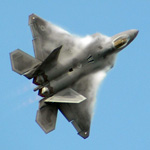AFRL develops ‘snubber’ to prevent engine damage

An innovative solution from the Air Force Research Laboratory is expected to save the Air Force upwards of $40 m. The $35 “snubber” developed by the Propulsion Directorate is a vibration damper that will prevent cracks in the J-seal on the F119 engine’s inlet case, a spoked, ring-like device that helps control the air going into the engine. Previously, if cracks were discovered, the engine would need to be pulled and the end of the crack drilled to stop it from growing. If any problems arose during drilling, the $362,000 inlet case had to be discarded.
The Aeronautical Systems Center F-22 Division contacted the Propulsion Directorate just across the street at Wright-Patterson and asked it to study the problem. The directorate responded with the snubber in a mere six months.
“In the turbine engine world, we have a lot of interaction with the program offices for numerous engines,” said Dr. Charles Cross, chief of the Propulsion Directorate’s Turbine Engine Structures Branch. “We have programs set up to do information exchanges so that we know what problems are coming down the pike, and we can see if we have anything that we can apply to them.”
The little orange snubber looks like an exotic pencil eraser and fits in the gap opposite where the J-seal is welded to the inlet case. Seven $35 snubbers are fit on each engine, meaning outfitting each F-22 costs $245.
“On the F119, we hope this will eliminate a huge maintenance driver at a very, very low cost,” said Stephen Brinkman, F119 Fan and Compressor WBS manager for the F-22 Division. “You would not believe how expensive these parts are. And that’s the beauty of it — it’s such a simple, cheap fix.”
The snubbers began being used in April 2011, and about 3,000 flight hours have been logged. They were designed to last half the life of the engine, but because they’re so cheap, new ones will be installed whenever the engine is pulled.
“It’s a pretty big deal for us,” said Brian Runyon, principal investigator, on transitioning this solution so quickly to the field. “For most of us this is a once-in-a lifetime opportunity.”
In the long term, the plan is to show that the old cracks don’t grow once the snubbers are installed, and further stop drilling won’t be required. Once more data is collected, it is thought the engines will be “snubbed” and left alone.